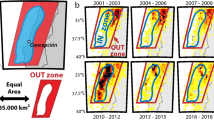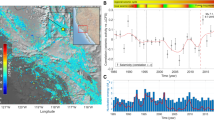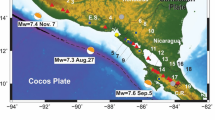Abstract
The mechanism responsible for the triggering of earthquakes remains one of the least-understood aspects of the earthquake process. The magnitude-7.3 Landers, California earthquake of 28 June 1992 was followed for several weeks by triggered seismic activity over a large area, encompassing much of the western United States1. Here we show that this triggered seismicity marked the beginning of a five-year trend, consisting of an elevated microearthquake rate that was modulated by an annual cycle, decaying with time. The annual cycle is mainly associated with several hydrothermal or volcanic regions where short-term triggering was also observed. These data indicate that the Landers earthquake produced long-term physical changes in these areas, and that an environmental source of stress—plausibly barometric pressure—might be responsible for the annual variation.
This is a preview of subscription content, access via your institution
Access options
Subscribe to this journal
Receive 51 print issues and online access
$199.00 per year
only $3.90 per issue
Buy this article
- Purchase on Springer Link
- Instant access to full article PDF
Prices may be subject to local taxes which are calculated during checkout





Similar content being viewed by others
References
Hill, D. P. et al. Seismicity remotely triggered by the magnitude 7.3 Landers, California, earthquake. Science 260, 1617 –1623 (1993).
Reasenberg, P. A. Second-order moment of central California seismicity 1969–1982. J. Geophys. Res. 90, 5479–5495 (1985).
Gomberg, J. & Davis, S. Stress/strain changes and triggered seismicity at The Geysers, California. J. Geophys. Res. 101, 733–749 (1996).
Hill, D. P., Johnston, M. J. S., Langbein, J. O. & Bilham, R. Response of Long Valley caldera to the M w = 7.3 Landers, California, earthquake. J. Geophys. Res. 100, 12985–13005 (1995).
Anderson, J. G. et al. Seismicity in the western Great Basin apparently triggered by the Landers, California, Earthquake, 28 June 1992. Bull. Seismol. Soc. Am. 84, 863–891 ( 1994).
Gomberg, J. & Bodin, P. Triggering of the M s = 5.4 Little Skull Mountain, Nevada, earthquake with dynamic strains. Bull. Seismol. Soc. Am. 84, 844– 853 (1994).
Linde, A. T. Increased pressure from rising bubbles as a mechanism for remotely triggered seismicity. Nature 371, 408– 410 (1994).
King, G. C. P., Stein, R. S. & Lin, J. Static stress changes and the triggering of earthquakes. Bull. Seismol. Soc. Am. 84, 935– 953 (1994).
Gomberg, J., Beeler, N. M., Blanpied, M. L. & Bodin, P. Earthquake triggering by transient and static deformations. J. Geophys. Res. 103, 24411–24426 (1998).
Sturtevant, B., Kanamori, H. & Brodsky, E. E. Seismic triggering by rectified diffusion in geothermal systems. J. Geophys. Res. 101, 25269– 25282 (1996).
Roeloffs, E. in Advances in Geophysics Vol. 37 (ed. Dmowska, R.) 135 –195 (Academic, San Diego, California, 1996).
Stein, R. S. & Lisowski, M. The 1979 Homestead Valley earthquake sequence, California; control of aftershocks and postseismic deformation. J. Geophys. Res. 88, 6477– 6490 (1983).
Reasenberg, P. A. & Simpson, R. W. Response of regional seismicity to the static stress change produced by the Loma Prieta earthquake. Science 255, 1686– 1690 (1992).
Acknowledgements
The earthquake catalogue was obtained from the Northern California Data Center maintained by UC Berkeley and the USGS. The code for declustering catalogues was written by P. Reasenberg. We thank the National Climatic Data Center and E. Roeloffs and E. Quilty for providing precipitation data; E. Roeloffs, D. Oppenheimer, S. Solomon, L. Knopoff, F. Press and H. Liu for discussions; and J. Gomberg for comments that significantly improved the manuscript.
Author information
Authors and Affiliations
Corresponding author
Rights and permissions
About this article
Cite this article
Gao, S., Silver, P., Linde, A. et al. Annual modulation of triggered seismicity following the 1992 Landers earthquake in California. Nature 406, 500–504 (2000). https://doi.org/10.1038/35020045
Received:
Accepted:
Published:
Issue Date:
DOI: https://doi.org/10.1038/35020045
This article is cited by
-
Extreme rainfall triggered the 2018 rift eruption at Kīlauea Volcano
Nature (2020)
-
Dynamic Multifractality of Seismic Activity in Northeast India
Pure and Applied Geophysics (2019)
-
Hydrologically-driven crustal stresses and seismicity in the New Madrid Seismic Zone
Nature Communications (2017)
-
Spectral coherence between climate oscillations and the M ≥ 7 earthquake historical worldwide record
Natural Hazards (2015)
-
Remote triggering of fault-strength changes on the San Andreas fault at Parkfield
Nature (2009)
Comments
By submitting a comment you agree to abide by our Terms and Community Guidelines. If you find something abusive or that does not comply with our terms or guidelines please flag it as inappropriate.



